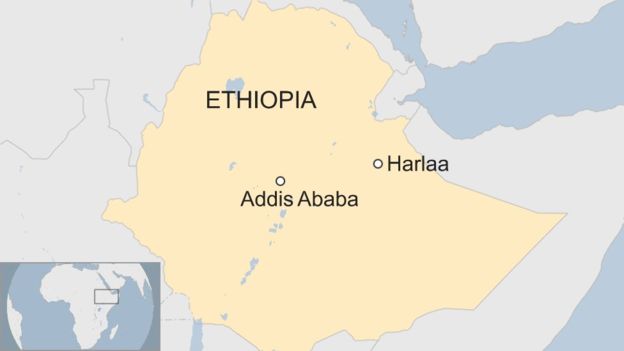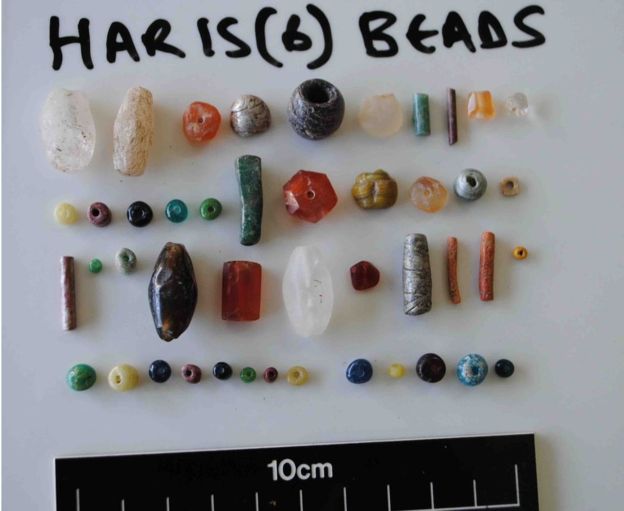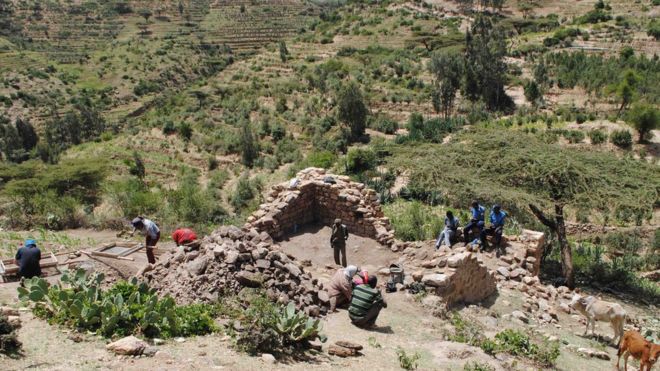It looks like you're using an Ad Blocker.
Please white-list or disable AboveTopSecret.com in your ad-blocking tool.
Thank you.
Some features of ATS will be disabled while you continue to use an ad-blocker.
22
share:

A forgotten city thought to date back as far as the 10th century AD has been uncovered by a team of archaeologists in eastern Ethiopia. Artefacts from Egypt, India and China have been found in the city in the Harlaa region. The archaeologists also uncovered a 12th Century mosque which is similar to those found in Tanzania and Somaliland. Archaeologists says this proves historic connections between different Islamic communities in Africa.
"This discovery revolutionises our understanding of trade in an archaeologically neglected part of Ethiopia. What we have found shows this area was the centre of trade in that region," lead archaeologist Professor Timothy Insoll from the University of Exeter said.

The team also found jewellery and other artefacts from Madagascar, the Maldives, Yemen and China. Harlaa was a "rich, cosmopolitan" centre for jewellery making, Prof Insoll said. "Residents of Harlaa were a mixed community of foreigners and local people who traded with others in the Red Sea, Indian Ocean and possibly as far away as the Arabian Gulf," he said. 'City of giants' BBC Ethiopia correspondent Emmanuel Igunza says there was a local myth that the area was occupied by giants because the settlement buildings and walls were constructed with large stone blocks that could not be lifted by ordinary people. However the archaeologists found no evidence of this. "We have obviously disproved that, but I'm not sure they fully believe us yet," said Prof Insoll.
www.bbc.com...
More medieval trade networks, in other threads of this nature I introduced the Swahili end of the world wide contacts, but while they figured large, further north in the empire of Axum and the Ajuran Sultanate of Somali part of the same network, matter of fact more anciently Punt, lay somewhere along the Somali coast or Eritrea , although signs point more to Eritrea because of the mummified baboons found in Egypt, but Axum was a world power centuries before that , they even made certain territorial claims in parts of India , although that would more likely be diplomatic bullying more so than military.
The sudden appearance and disappearance of Aksumite coins in the Indian Ocean region in the late third century remains an enigmatic clue to a dynamic phase of international trade and diplomacy. This study will explore how the Aksumite kingdom of Ethiopia used imitation of Byzantine coins as part of its strategy to usurp the role of the eastern Roman Empire in long-distance trade with the East. These coins demonstrate a flourishing and self-confident polity, but also illustrate the importance of cultural tradition in the pursuit of maritime trade.
www.rosetta.bham.ac.uk...

Ruins of a 10th century Mosque in the same style as the Swahili and Somali.
Nice find! This would be about the time that pottery and glass trades were really taking off across the world -- the beads are beautiful! Clear
glass like the delightful red bead would have replaced carnelian or ruby beads.
This is a busy week for me; I hope you'll link some material on the Aksumite kingdom for me to read.
This is a busy week for me; I hope you'll link some material on the Aksumite kingdom for me to read.
It is strange that an article about trade neglects to mention islamic slavery.
Slavery was integral to trade throughout the muslim world.
Slavery was integral to trade throughout the muslim world.
Before the imperial expansion to the south Asandabo, Saqa, Hermata and Bonga were the primary slave markets for the kingdom of Guduru, Limmu-Enaria, Jimma and Kaffa.[12] The merchant villages adjacent to these major markets of southwestern Ethiopia were invariably full of slaves, which the upper classes exchanged for the imported goods they coveted. The slaves were walked to the large distribution markets like Basso in Gojjam, Aliyu Amba and Abdul Resul in Shewa.[13] The primary source of slaves for the southern territories was the continuous wars & raids between various clans and tribes which has been going on for thousands of years, and it usually follows with large scale slavery that was very common during the battles of that era.[14][15][16][17][18] Slaves were often provided by Oromo and Sidamo rulers who raided their neighbors or who enslaved their own people for even minor crimes.[15] According to Donald Levine, it was common to see Boranas making slaves of Konso, Oromos being sold by other Oromo speaking clans and Afars making slaves of Amhara.[19][20] Famine is another source of slaves, and during times of recurrent drought and widespread cattle disease, slave markets throughout the country will be flooded with victims of famine. For instance, the Great famine of 1890-91 forced many people from the Christian north as well as southern Ethiopia to even sell their children and, at times, themselves to Muslim merchants.[21] Since religious law did not permit Christians to participate in the trade, Muslims dominated the slave trade, often going farther and farther afield to find supplies.[22]
en.m.wikipedia.org...
edit on 18-6-2017 by Deny Arrogance because: (no reason given)
a reply to: Deny Arrogance
Not quite as strange as attempting to use information about trade networks set up at the prime of Aksum's power (and this newly found site was a part of that trade network primarily around jewelry making) and then trying to somehow tie it in with the Islamic slave trade, which from your own citation, was relegated primarily to the southern parts of Ethiopia in regards to the scope of the slave markets. Though the slave trade was endemic throughout all of Ethiopia until 75 years ago when it was finally outlawed upon Ethiopian independence, the site presented in the OP played no role in the international slave market under Islamic law.
Not quite as strange as attempting to use information about trade networks set up at the prime of Aksum's power (and this newly found site was a part of that trade network primarily around jewelry making) and then trying to somehow tie it in with the Islamic slave trade, which from your own citation, was relegated primarily to the southern parts of Ethiopia in regards to the scope of the slave markets. Though the slave trade was endemic throughout all of Ethiopia until 75 years ago when it was finally outlawed upon Ethiopian independence, the site presented in the OP played no role in the international slave market under Islamic law.
a reply to: peter vlar
Where there are mosques there are muslims.
Where there are muslims there is slavery.
This is established historical fact, denier.
Where there are mosques there are muslims.
Where there are muslims there is slavery.
This is established historical fact, denier.
originally posted by: Deny Arrogance
a reply to: peter vlar
Where there are mosques there are muslims.
So because there is a photo of a mosque then somehow the city was controlled by Muslims during the Aksom's period of regional power? FYI, Ethiopia was a Christian Kingdom at the time the city in the OP fell into ruin.
Where there are muslims there is slavery.
There are Muslims down the street from me. I've yet to see a slave in the 14 years I've owned this home. So no, where there are Muslims, there are no promises of slavery.
This is established historical fact, denier.
The only thing I am denying is that you actually looked at anything beyond a picture of a mosque prior to running heater skelter with your own myopic vision of events.
For those of us that appreciate the totality of our worlds history, we look at the whole picture. In this case, nobody is denying the fact that Muslims have been in Ethiopia since Muhammad was still living. But the Isamic slave trade you are attempting to tie to this specific historical period did not exist until after the Abyssinian War in the early 16th century. These my friend are historical facts. The only one here denying the facts and attempting to run their own narrative into the ground I said you.
So now that we have established some basic facts, perhaps you could clarify exactly why the OP should have made mention of Islamic slavery in a city and at a time that it didn't exist?
a reply to: Deny Arrogance
This is a great discovery, revealing yet more threads of the pasts' rich tapestry. The beads the selves are fresh and beautiful.
Towards the end of the BBC piece it says...”Islam arrived in Ethiopia in the 7th Century as early Muslim disciples fled persecution in Mecca." which strikes me as a "historical fact" I should find out more about.
Slavery, back when this city flourished, was the norm across most of the 'civilised' world, and very common practice - a bit like trolling on ATS!
Equally, like a troll, ancient slavery isn't something we should find tolerable, but not really worth making much of a noise about either as it is, as you say, a "historical fact".
This is a great discovery, revealing yet more threads of the pasts' rich tapestry. The beads the selves are fresh and beautiful.
Towards the end of the BBC piece it says...”Islam arrived in Ethiopia in the 7th Century as early Muslim disciples fled persecution in Mecca." which strikes me as a "historical fact" I should find out more about.
Slavery, back when this city flourished, was the norm across most of the 'civilised' world, and very common practice - a bit like trolling on ATS!
Equally, like a troll, ancient slavery isn't something we should find tolerable, but not really worth making much of a noise about either as it is, as you say, a "historical fact".
originally posted by: Doxanoxa
a reply to: Deny Arrogance
Towards the end of the BBC piece it says...”Islam arrived in Ethiopia in the 7th Century as early Muslim disciples fled persecution in Mecca." which strikes me as a "historical fact" I should find out more about.
Muhammad himself fled from Mecca to Ethiopia. There's not really any question on the presence of Islam in Ethiopia from nearly the beginning. However, they were a tiny group of people initially and Muhammad commanded his followers to follow the dictates of the Christians who were running the show. They certainly weren't running an international slave trade from Ethiopia until after the 14 year long Abyssinian War from 1429-1443. That's when Islam finally gained a firm foothold in Ethiopia. Even today, Christians are the majority in Ethiopia with only about 1/3 of the populace being Muslims. It's a pretty fascinating period of time so if you're interested, I strongly encourage you to take a peek for yourself and see how the facts stack up against the narrative.
a reply to: Deny Arrogance
Virtually all kingdoms be it Christian, Islamic or Pagans, dealt in slaves, but as was said by Peter ,time and context also matters, remember that ill fated children's crusade?? after marching thousands of children, starving and sick across Europe with promises of glory in Jerusalem, the Christian adults leading them, promptly sold them into slavery after reaching the warm waters of the Mediterranean to their Muslim enemy.
Virtually all kingdoms be it Christian, Islamic or Pagans, dealt in slaves, but as was said by Peter ,time and context also matters, remember that ill fated children's crusade?? after marching thousands of children, starving and sick across Europe with promises of glory in Jerusalem, the Christian adults leading them, promptly sold them into slavery after reaching the warm waters of the Mediterranean to their Muslim enemy.
edit on 18-6-2017 by Spider879 because: (no reason given)
new topics
-
What Comes After January 20th
Mainstream News: 29 minutes ago -
Canada as a state .. how would it work?
General Chit Chat: 38 minutes ago -
Those stupid GRAVITE commercials
Rant: 1 hours ago -
Let's Buy Greenland
General Chit Chat: 2 hours ago -
Planned Civil War In Britain May Be Triggered Soon
Social Issues and Civil Unrest: 5 hours ago -
Claim: General Mark Milley Approved Heat and Sound Directed Energy Weapons During 2020 Riots
Whistle Blowers and Leaked Documents: 6 hours ago
top topics
-
Claim: General Mark Milley Approved Heat and Sound Directed Energy Weapons During 2020 Riots
Whistle Blowers and Leaked Documents: 6 hours ago, 10 flags -
Planned Civil War In Britain May Be Triggered Soon
Social Issues and Civil Unrest: 5 hours ago, 5 flags -
What Comes After January 20th
Mainstream News: 29 minutes ago, 4 flags -
Let's Buy Greenland
General Chit Chat: 2 hours ago, 3 flags -
Those stupid GRAVITE commercials
Rant: 1 hours ago, 2 flags -
Canada as a state .. how would it work?
General Chit Chat: 38 minutes ago, 0 flags
active topics
-
Let's Buy Greenland
General Chit Chat • 10 • : CriticalStinker -
Those stupid GRAVITE commercials
Rant • 3 • : Cre8chaos79 -
Canada as a state .. how would it work?
General Chit Chat • 5 • : CriticalStinker -
What Comes After January 20th
Mainstream News • 3 • : UpIsNowDown2 -
Gravitic Propulsion--What IF the US and China Really Have it?
General Conspiracies • 30 • : Lazy88 -
Remember These Attacks When President Trump 2.0 Retribution-Justice Commences.
2024 Elections • 133 • : Oldcarpy2 -
Sorry to disappoint you but...
US Political Madness • 40 • : cherokeetroy -
January 6th report shows disturbing trend (nobody is shocked)
US Political Madness • 72 • : JadedGhost -
-@TH3WH17ERABB17- -Q- ---TIME TO SHOW THE WORLD--- -Part- --44--
Dissecting Disinformation • 3954 • : Thoughtful3 -
Claim: General Mark Milley Approved Heat and Sound Directed Energy Weapons During 2020 Riots
Whistle Blowers and Leaked Documents • 20 • : NoCorruptionAllowed
22
